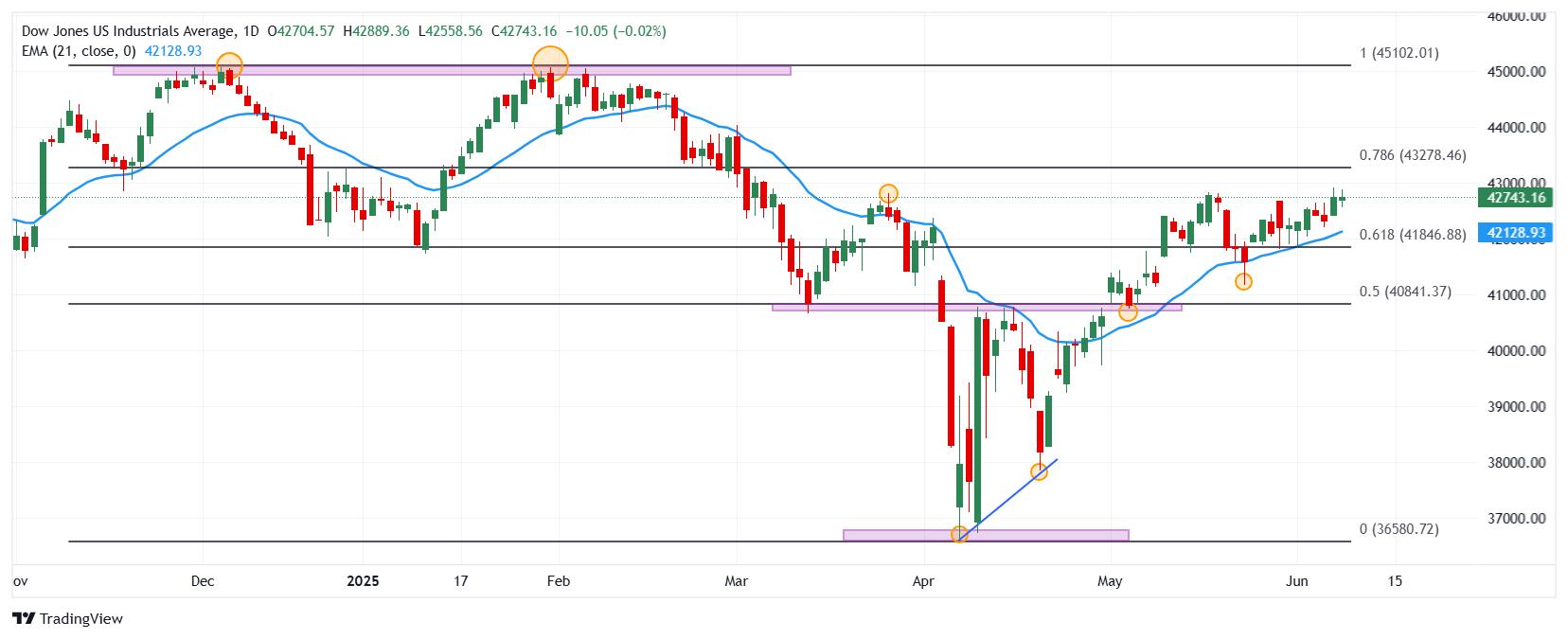- The Dow Jones goes back 0.02% daily, consolidating within the operating range of June 6 in 42743.
- The Nasdaq 100 wins 0.17% in the day, reaching maximum of June 5 at 21,855.
- The S&P 500 rises 0.06% today, driven by Enfase Energy (ENPH).
- Investors focus their attention on the round of negotiations between officials in the United States and China.
The Dow Jones established a maximum of the day in 42,889, attracting vendors that dragged the index to a daily minimum in 42,558.
The Dow Jones industrial average opened at 42,704, while the Nasdaq 100 technological index began operating in 21,769. The S&P 500 began negotiations in 5,996, maintaining the short -term bullish perspective.
The Dow Jones closes with marginal losses dragged by The Travelers Companies and Nike
The Dow Jones index fell 0.02% on Monday, reaching a minimum of the session at 42,558.
The shares of The Travelers Companies (TRV) slide 2.16% today, visiting May 14 at 262.93 $, leading losses in the stock market index.
In this sense, Nike (NKE) titles lose 1.42% daily, reaching minimum of June 3 in $ 61.88. NKE will announce its profit report on June 26, where it is expected to obtain 10.7 billion dollars in income and $ 0.115 in earnings per share.
The Dow Jones loses 10 in the day, currently quoting at 42,743.
The Nasdaq 100 is quoted in the animated profit zone by regeneon Pharmaceuticals and Advanced Micro Devices
The Nasdaq 100 technological index wins 0.17% than the first day of the week, reaching maximum of June 5 in 21,855.
The values of Regeneron Pharmaceuticals (REGN) rebound 4.94% today, visiting maximums not seen since May 30 in 518.27 $, spinning two consecutive sessions with profits.
In the same tonic, the actions of Advanced Micro Devices (AMD) advance 4.76% in the day, reaching May 14 at 122.37 $, signing its second consecutive day on the rise.
In this context, the Nasdaq 100 advances 36 points, operating when writing about 21,785.
The S&P 500 extends its profits the means of commercial negotiations between the United States and China
The commercial rhetoric led by Donald Trump has relaxed by looking for another round of negotiations with China, while investors expect tariff restrictions to decrease.
In this sense, the S&P 500 rises 0.06% in the day, reaching maximums not seen from February 24 in 6,018, spinning two consecutive days with profits.
Enfase Energy (ENPH) shares rebound 5.05% on Monday, reaching maximum of June 4 in 44.40, ending with a streak of three consecutive sessions with losses.
Technical Analysis of Dow Jones
The Dow Jones formed a short -term support given by the minimum of May 23 in 41,175. The following important support is observed in 40,747, minimum of May 6 in convergence with the 50% fibonacci setback. Upwards, the key resistance is 45,068, a pivot point of January 31, 2025.
Dow Jones daily graphics

Dow Jones Faqs
The Dow Jones Industrial Avenge, one of the oldest stock market indexes in the world, consists of the 30 most negotiated values in the United States. The index is weighted by the price instead of capitalization. It is calculated by adding the prices of the values that compose it and dividing them by a factor, currently 0.152. The index was founded by Charles Dow, also founder of the Wall Street Journal. In recent years it has been criticized for not being sufficiently representative, since it only follows 30 companies, unlike broader rates such as S&P 500.
There are many factors that promote the Dow Jones Industrial Average (DJIA) index. The main one is the added performance of the companies that compose it, revealed in the quarterly reports of business benefits. The American and world macroeconomic data also contribute, since they influence investor confidence. The level of interest rates, set by the Federal Reserve (FED), also influences the DJia, since it affects the cost of credit, on which many companies depend largely. Therefore, inflation can be a determining factor, as well as other parameters that influence the decisions of the Federal Reserve.
Dow’s theory is a method to identify the main trend of the stock market developed by Charles Dow. A key step is to compare the direction of the Dow Jones Industrial Avenge (DJIA) and the Dow Jones Transportation Average (DJTA) and just follow the trends in which both move in the same direction. The volume is a confirmation criterion. The theory uses elements of maximum and minimum analysis. Dow’s theory raises three phases of the trend: accumulation, when intelligent money begins to buy or sell; Public participation, when the general public joins the trend; and distribution, when intelligent money abandons the trend.
There are several ways to operate with the DJ. One of them is to use ETF that allow investors to negotiate the DJ as a single value, instead of having to buy shares of the 30 companies that compose it. An outstanding example is the SPDR Dow Jones Industrial Avenge ETF (day). Future contracts on the DJ allow the specular operators about the future value of the index and the options provide the right, but not the obligation, to buy or sell the index at a predetermined price in the future. Investment funds allow investors to buy a part of a diversified portfolio of DJ values, which provides exposure to global index.
Source: Fx Street
I am Joshua Winder, a senior-level journalist and editor at World Stock Market. I specialize in covering news related to the stock market and economic trends. With more than 8 years of experience in this field, I have become an expert in financial reporting.





